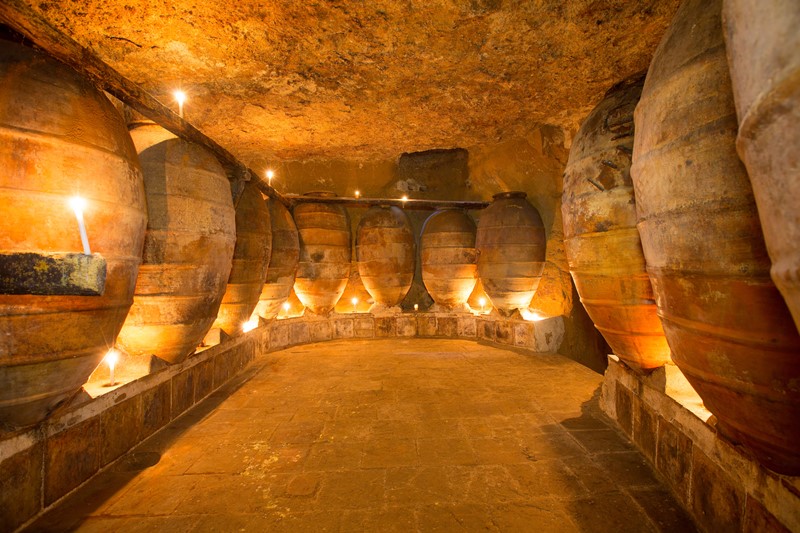The clay amphorae: a millennia-old legacy in winemaking
Understanding the clay amphora, more than just a vessel

Throughout the annals of time, certain practices and traditions, through their sheer elegance and practicality, have transcended generations, languages, cultures, and continents. One such tradition is the use of clay amphorae, an integral element in the history of winemaking. This tale, steeped in time and tradition, traces back to ancient Aegean, Phoenician, Roman, and Greek cultures, who all recognized the significance of these vessels in the conservation, transportation, and trade of wine.
The clay amphora is essentially a container designed to store wine, oil, grain, and other foodstuffs. It remains one of the most ancient innovations of mankind and could arguably be considered a revolutionary development in commerce and the preservation of essential goods for the sustenance of civilizations. It offered a particularly ideal solution for maritime and river transport.
These ceramic vessels came in diverse sizes, dictated by their intended purpose. Designed with handles for ease of transport, they sported a variety of designs. Some were elongated with slender necks, while others featured wide mouths and a typically ovate body.
Amphorae stand not merely as artifacts, but also as tangible chronicles of human history. Archaeological findings of these vessels shed light on the diets of ancient communities, the kind of crafts they practiced, and how they solved logistical and trade-related challenges.
They also doubled as canvases for artistic expression, with some amphorae featuring rich decorations. Based on the designs and embellishments, it is possible to determine the civilization they belonged to. Notable examples of such distinctive pottery styles are evident in amphorae from Corinth, Samos, or Lesbos.
The stamps imprinted on the ceramics are pivotal in archaeological and historical research. Every merchant or city had its unique stamps and stoppers, which identified the wines, ensuring traceability, and provided an insight into their quality and origin.
Tracing the origins: who used the amphorae first?
Clay amphorae for wine production and storage hark back to ancient times, having been utilized by various civilizations. Evidence suggests that clay amphorae were first used during the Neolithic period, about 8,000 years ago, by the inhabitants of the Caucasus region, present-day Georgia. There is also proof that the ancient Phoenicians and Egyptians, and later, the Greeks and Romans used clay amphorae to store and transport wine in large quantities. This evidence indicates the practice spread throughout the Mediterranean world and beyond.

The purpose of clay amphorae: more than just storage
Ceramic amphorae were primarily used to store and transport foodstuffs. The designs and sizes were adaptable based on their function. Consequently, we find richly decorated, smaller amphorae for domestic use, and larger ones designed for the transport of wine, oil, garum, and other products by ship.
The Roman amphora for wine is well-known, largely due to the significant number of them found, mostly from shipwrecks and ancient cities. The Romans even scaled down their size to facilitate transport by two people to the ship cellars.
However, these vessels were sturdy but not ideal for land transportation. Due to their shape, they were challenging to fit in land vehicles, and the clay could easily break. As a result, the Romans gradually phased them out, replacing them with oak barrels.
The importance of amphorae in winemaking
Clay amphorae were not only the primary vessel for transporting wine via sea trade routes. They also cultivated the Greeks' and Romans' taste for aged wines. Storing wine in clay vessels imparts unique aroma and flavor characteristics, which were favored by these civilizations. The amphorae were treated with pitch to make them waterproof, allowing the wine to be preserved much longer without turning into vinegar.

Today, we are witnessing a resurgence of clay vessels for winemaking. The container used to age wine contributes distinct organoleptic properties. In fact, the nuances that barrels bring to wine are widely admired.
For a long time, wineries largely abandoned the use of jars and amphorae, which became vestiges of bygone times. Although clay in viticulture has never completely disappeared—as evidenced by amphora or jar wines—contemporary oenological trends are seeing a resurgence of clay. Organic and biodynamic viticulture is seeking more natural materials than stainless steel, which can bring new nuances to the wine.
Proponents of this trend argue that aging in clay amphorae better respects the unique character that the terroir imparts to the wine while enhancing the characteristics of native grape varieties.
It's also noteworthy that amphorae are currently being used to create exclusive, luxurious packaging in collaboration with ceramic artists who elevate craftsmanship to the status of art.
The humble clay amphorae narrate the history of civilizations through wine. The resurgence in their use underlines the enduring relevance of a design that has withstood the test of centuries. The clay amphora, the silent sentinel of winemaking, continues its age-old dance with time and tradition, preserving the past and flavoring the future with every drop of wine it holds.
Founded in 2007, Vinetur® is a registered trademark of VGSC S.L. with a long history in the wine industry.
VGSC, S.L. with VAT number B70255591 is a spanish company legally registered in the Commercial Register of the city of Santiago de Compostela, with registration number: Bulletin 181, Reference 356049 in Volume 13, Page 107, Section 6, Sheet 45028, Entry 2.
Email: [email protected]
Headquarters and offices located in Vilagarcia de Arousa, Spain.